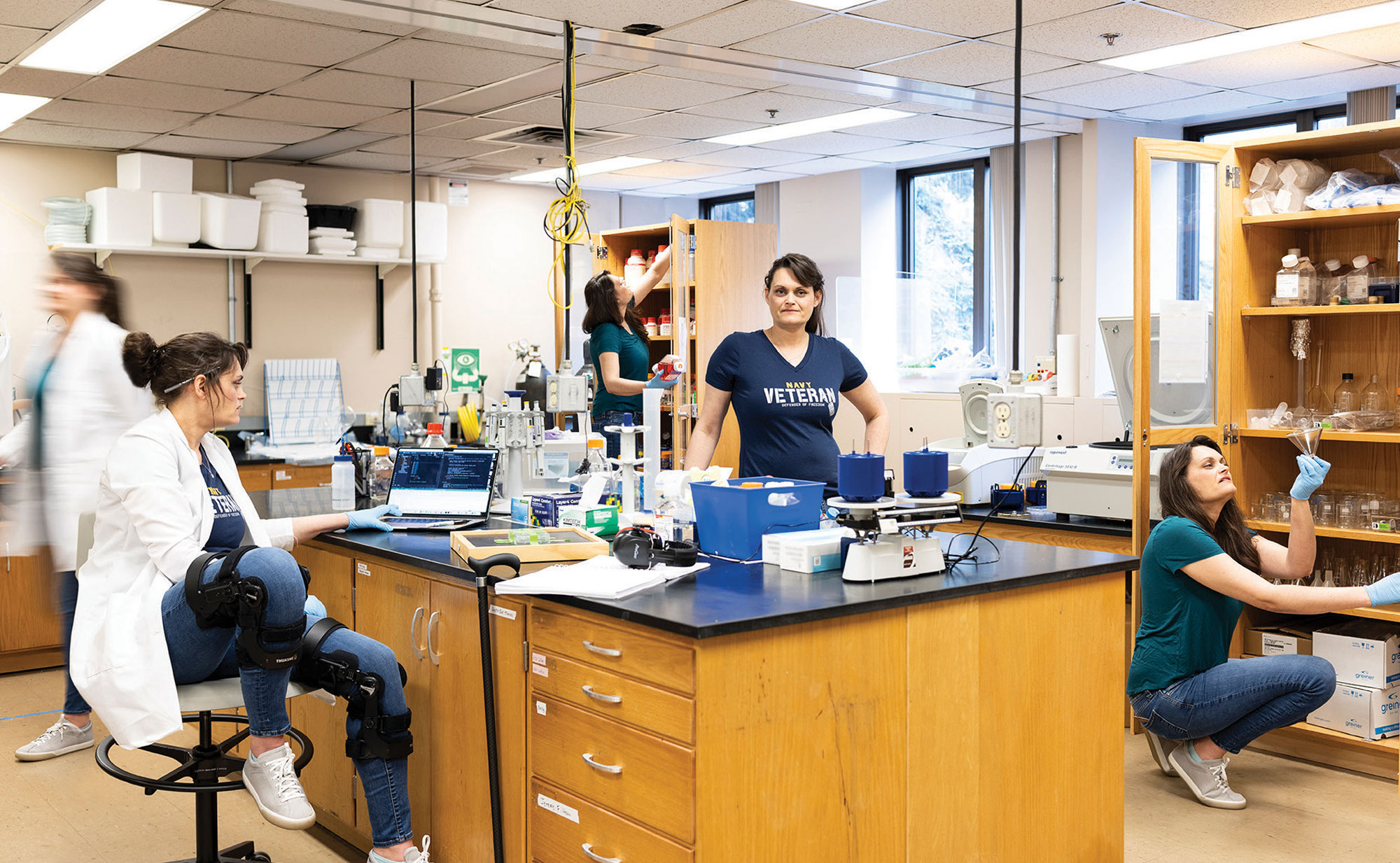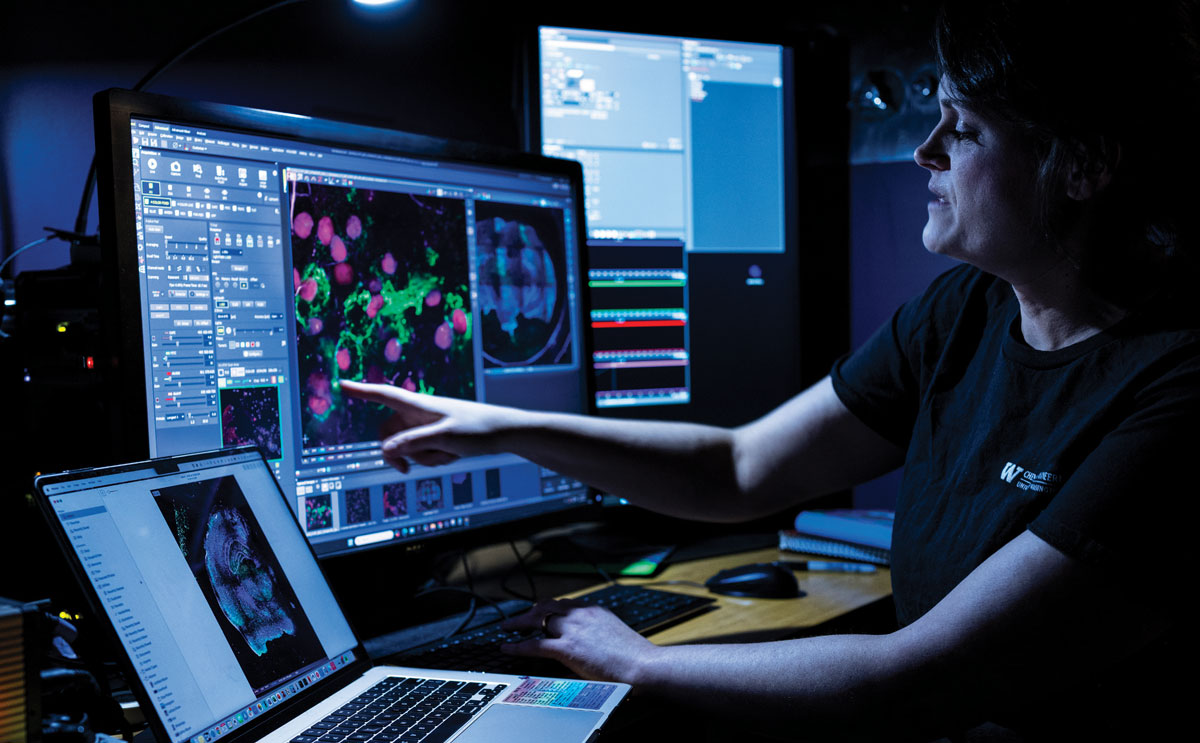Serving in science Serving in science Serving in science
From the Navy to the UW, Kristin Bennett's journey has sparked innovations in studying brain injury—and making education accessible.

From the Navy to the UW, Kristin Bennett's journey has sparked innovations in studying brain injury—and making education accessible.
It’s 3 a.m., and Benson Hall is quiet. In the dimly lit second- floor hallway of the Nance Lab, undergraduate Kristin Bennett, ’25, opens a refrigerator and pulls out a container of brain tissue.
With tweezers, Bennett carefully picks up a photosensitive slice and examines it under a microscope, scanning the sample at 10x magnification, then 40x. Scrutinizing the tiny universe found in one sliver of tissue, she says, “It’s so much to explore.”
Bennett is studying thin slices of brain tissue grown in vitro under controlled conditions through a method pioneered by lab director Elizabeth Nance, a UW associate professor of chemical engineering and bioengineering. By studying living samples of different ages and from different areas of the brain, Nance’s researchers aim to better understand how the brain reacts to disease and injury, including traumatic brain injury (TBI). Undergraduate research is an important part of the Husky experience for many University of Washington students—but as a 43-year-old Navy veteran, Bennett is not your typical undergrad.
For six years, Bennett was a nuclear chemist on a Navy aircraft carrier deployed to Iraq and Afghanistan. “Service is what my whole life has been about,” she says, reflecting on her calling to serve as one of the few women in a newly integrated field, managing the mechanical systems and chemistry of the craft’s nuclear reactor. Bennett’s role included decontaminating personnel exposed to radioactivity before they could receive medical treatment. During her duty, she was exposed to toxic burn pits, ionizing radiation and hazardous chemicals—leaving a lasting impact on her health.
By age 28, Bennett had suffered multiple ministrokes, losing function on her right side. By 40, she developed autoimmune disorders and lost 40% of her lung capacity, leading to a 90% disability rating for service-connected conditions. Describing the treatments as “horrific,” she endured pain, nausea, emotional numbness and difficulty connecting with others. She spent years in recovery—relearning how to talk, walk and do math.
There were no medicines for the rare condition that caused Bennett’s ministrokes. That dismaying fact, she learned, was also true for TBI, the most prevalent brain injury. Her call to service evolved.
Each year, TBI afects 67 million people globally and 1.5 million in the U.S. The lack of treatments costs the U.S. health care system $40 billion annually. Knowing that veterans with TBI are 22 times more likely to die from health-related conditions, Bennett was determined to make an impact.
Thanks to her Veterans Vocational Rehabilitation benefits, Bennett was offered a full college scholarship and a salary, allowing her to start college at 38. She completed pre-requisites at Seattle Colleges and then transferred to the UW. Accepted into both chemical engineering and bioengineering, Bennett was recruited by Nance to the Department of Chemical Engineering and selected for the professor’s lab.
“Private funding support allows me to serve the UW community, our veteran community and every person affected by traumatic brain injury. The most rewarding thing about being in school at this stage of my life is the continued opportunity to serve.”
Kristin Bennett
The Nance Lab is one of a few in the world exploring brain injury and treatment through multiple-particle tracking techniques that use nanoparticles to probe living brain tissue. Researchers are studying how the brain parenchyma—the functional tissue of the brain—acts as a barrier to therapeutic drug delivery and how it responds to stimuli and treatment.
Bennett adapted the Nance slice model to investigate the mechanics and physics of TBI. In doing so, she created a potentially more controllable and tunable method of introducing injury in the brain samples using acoustic waves. This innovative approach laid the groundwork for her ongoing research—the surface acoustic wave (SAW) model. In recognition, Bennett was awarded the prestigious Washington Research Foundation Fellowship in 2023.

Bennett examines a high-resolution image of brain tissue taken with a confocal microscope, which uses lasers to illuminate brain cells and their nuclei.
“I would never have been able to develop the SAW model without the Washington Research Foundation,” Bennett says. The program gave her the freedom to explore her curiosity without limitations, allowing her to push the boundaries of the field. With funding for her project, Bennett was able to build on existing research and invent SAW. She adds, “WRF jump-starts the imagination and careers of every student they touch.”
Bennett’s journey to TBI research led organically to supporting scholars with disabilities. Her own disability from her time in the service reshaped how she processes information, giving her a unique perspective. “Having firsthand experience enables me to ask questions others may not, which leads to innovative modeling and solutions,” she says. “That’s why inclusion is so important—people from diverse backgrounds bring different perspectives to a problem.” While only 3% of STEM researchers identify as having a disability, 27% of Americans are disabled, leaving a gap of lived experience in these fields.
In 2024, Bennett was named a Mary Gates Leadership Scholar for designing and implementing a curriculum to promote inclusion and ally-ship in engineering. The award, which helps UW undergraduates develop leadership skills, funded her efforts to make engineering education more inclusive. She led changes in curricula and classrooms to ensure that they were accessible to all students—not just those with declared disabilities and accommodations. “I’m not afraid of failing,” Bennett says of her work, “I’m afraid of not trying.”
Through Bennett’s leadership, over 70% of her department’s teaching faculty adopted universal design principles—a framework for improving usability and accessibility. “The likelihood of working with, supervising or becoming someone with a disability is quite high,” she says. “As a student with disabilities, this allowed me to make a difference for others.” Her long-term goal is to see these accessibility measures used across the University.
For the near future, Bennett will continue her work at the Nance Lab as a UW chemical engineering graduate student. She plans to apply therapeutics to the SAW model, hoping to find an effective treatment for brain injuries and advance to clinical trials. Since 2004, there have been 138 clinical trials for TBI; all of them have failed. Bennett is determined to change that outcome.
“Private funding support allows me to do this—to serve the UW community, our veteran community and every person affected by TBI,” says Bennett. “The most rewarding thing about being in school at this stage of my life is the continued opportunity to serve.”
Philanthropy has been crucial in supporting not only Bennett's research but the work of all researchers at the Nance Lab. Private donations fuel the success of the lab, making it possible for faculty, grad students and undergrads like Bennett to do the kinds of high-risk and exploratory research projects that can lead to discovery.
The changing landscape of funding has made private support even more vital, as many labs suddenly can no longer offer hands-on research opportunities. Without these investments, Bennett points out, “an entire generation of young scientists will be denied exposure to research early in their careers”—limiting the future of innovation in fields like brain injury and disease.
Associate Professor Nance notes that private support “is a critical piece in the bigger funding landscape. It provides opportunities for graduate students, faculty and undergraduates to carry out research.” She sums it up: “Philanthropy advances science.”